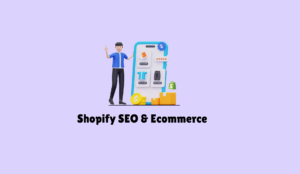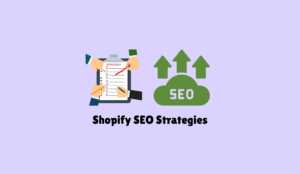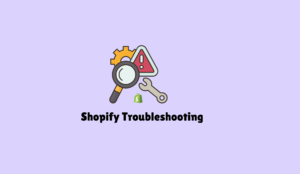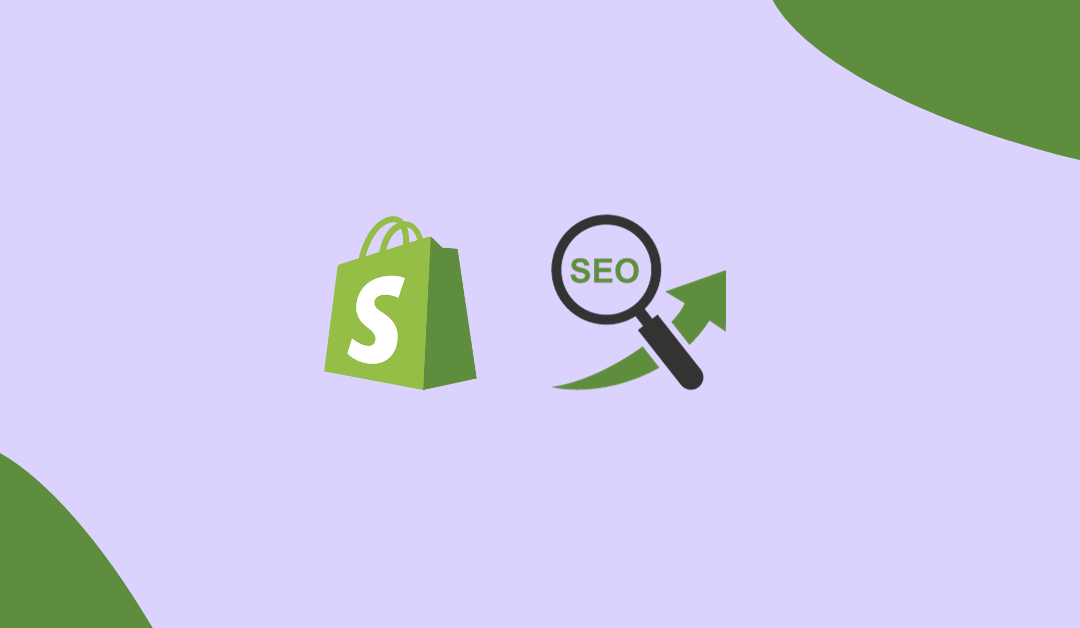This guide offers a comprehensive overview of how to leverage Shopify’s SEO capabilities to enhance your online store’s visibility and attract potential customers. By implementing Shopify SEO best practices, online retailers can significantly improve their chances of being discovered by search engines, leading to organic growth and increased sales.
This manual provides users with a step-by-step introduction to the strategies and recommended procedures for optimizing their Shopify store’s search engine ranking, helping businesses achieve long-term success and substantial increases in organic traffic.
Why Shopify SEO Matters for E-commerce
In the fast-paced world of e-commerce, the success of your Shopify store depends on its discoverability. Let’s discover why SEO is the driving force behind online success.

1. Targeted Traffic Means More Conversions
In the vast digital marketplace, attracting the right audience is crucial. SEO ensures that your products are not just visible, but are seen by users actively seeking what you offer. This targeted traffic is more likely to convert into satisfied customers, driving up your sales and revenue.
2. Enhanced User Experience
A positive user experience is vital for customer satisfaction and retention. SEO practices such as clean URLs, efficient navigation, and mobile optimization contribute to a consistent browsing experience. As users easily find what they’re looking for, they’re more likely to stay on your site, explore, and make purchases.
3. Outrank Competitors in Search Results
In the competitive e-commerce landscape, standing out is non-negotiable. Effective SEO propels your Shopify store up the search engine rankings, helping you outrank competitors. Higher visibility means more clicks, more visits, and ultimately, more sales.
Strategies for Shopify SEO Mastery
Now that we’ve established why Shopify SEO is a game-changer, let’s dive into the actionable strategies that will transform your store into an SEO powerhouse.

1. Keyword Research: The Foundation of SEO
Understanding Your Audience’s Language
Before diving into keyword research tools, take a step back to understand your target audience. What language do they use when searching for products similar to yours? What pain points are they trying to solve?
Utilizing Keyword Research Tools
Tools like Google Keyword Planner, SEMrush, and Ubersuggest are invaluable for identifying relevant keywords. Explore both short-tail and long-tail keywords to tailor your content to various search intents.
Integrating Keywords Seamlessly
Once you have your list of keywords, strategically incorporate them into your product descriptions, titles, meta tags, and even your blog content. Remember, it’s not just about ranking; it’s about connecting with your audience through language they resonate with.
2. Optimizing Product Pages for Conversions
Crafting Compelling Product Descriptions
Your product descriptions should go beyond mere features. Paint a picture of how your products solve problems or enhance the lives of your customers. Use descriptive language that resonates with your target audience.
Enhancing Visual Appeal
Images and multimedia are not just for aesthetics; they are crucial in keeping visitors engaged. Ensure high-quality images that showcase your products from different angles and provide a zoom-in feature for a closer look.
3. Technical SEO Best Practices for Shopify
Ensuring Mobile-Friendly Design
As the majority of online searches now happen on mobile devices, having a mobile-friendly website is not just a recommendation; it’s a necessity. Ensure your Shopify store’s design is responsive and provides an optimal experience across various screen sizes.
Implementing Clean and SEO-Friendly URLs
Your URLs play a role in both user experience and search engine ranking. Optimize your URLs by keeping them concise, relevant, and reflective of your content. Avoid generic strings of characters, and include keywords where appropriate.
4. Leverage the Power of Shopify Apps
Automating SEO Tasks
Shopify offers a variety of apps designed to streamline and automate SEO tasks. Explore apps that assist with keyword optimization, meta tag creation, and content scheduling. These tools can save time and ensure consistent SEO practices.
Tracking and Analyzing Performance
Utilize analytics apps to track the performance of your SEO efforts. Monitor key metrics such as organic traffic, conversion rates, and keyword rankings. Regularly review these analytics to identify what’s working well and where adjustments may be needed.
5. Strategic Internal Linking
Creating a User-Friendly Navigation
Internal links aid search engines in crawling and indexing your site and contribute to a user-friendly navigation experience. Create a logical structure with well-labeled categories and pages that guide visitors seamlessly through your store.
Distributing Link Equity Effectively
Strategic internal linking allows you to distribute link equity (SEO value) across your pages. Link from high-authority pages to those that may need a boost in search engine visibility. This helps establish a hierarchy of importance within your site.
6. Content Marketing for SEO Success
Starting a Blog on Your Shopify Store
Blogging is a powerful tool for both engaging your audience and improving SEO. Start a blog on your Shopify store to share valuable content related to your products, industry trends, and customer stories.
Developing a Content Strategy
Create a content calendar outlining topics, publication schedules, and promotion strategies. Consistent, high-quality content not only attracts organic traffic but also establishes your store as an authority in your niche.
7. Monitoring and Adaptation
Setting Up Google Analytics and Google Search Console
These tools are essential for monitoring your store’s performance. Google Analytics provides insights into user behavior, while Google Search Console offers data on how your site appears in search results. Set up both to gain a comprehensive view of your SEO efforts.
Regularly Reviewing and Adapting
The digital landscape is ever-evolving. Regularly review your analytics data and stay informed about industry trends. Adapt your SEO strategy accordingly, making data-driven decisions to stay ahead of the competition.
Strategies to Enhance Shopify SEO
Enhance Shopify SEO with these 6 advanced strategies to boost search rankings.

1. Advanced Keyword Strategies
Long-Tail Keywords and User Intent
Dig deeper into user intent by incorporating long-tail keywords. These more specific phrases not only attract highly targeted traffic, but also align with the nuanced searches your potential customers are making.
Competitor Analysis for Keyword Opportunities
Keep an eye on your competitors. Analyze their keywords and identify opportunities to capture untapped search terms. This can provide valuable insights into gaps in your keyword strategy.
2. Schema Markup Implementation
Enhancing Rich Snippets
Implementing schema markup on your Shopify store can result in rich snippets, providing users with more information directly in search results. This can include product reviews, prices, and availability, enhancing your store’s visibility and credibility.
Structured Data for Products
Utilize structured data to provide search engines with detailed information about your products. This not only helps with search visibility but can also contribute to appearing in specialized search results like Google’s Product Rich Snippets.
3. Optimizing for Voice Search
Conversational Keyword Integration
As voice search becomes more prevalent, adjust your keyword strategy to include conversational phrases. Consider how users would verbally ask questions related to your products and integrate these into your content.
FAQ Sections and Natural Language
Create FAQ sections on product pages with natural, conversational language. This not only caters to voice search but also provides valuable information to users clearly and concisely.
4. User-Generated Content and Reviews
Harnessing the Power of Reviews
Encourage customers to leave reviews on your product pages. Not only do positive reviews build trust with potential customers, but they also provide fresh, relevant content that can boost your SEO.
User-Generated Content on Social Media
Share user-generated content on your social media channels and link back to your Shopify store. This not only engages your audience but also creates valuable backlinks, contributing to your SEO efforts.
5. International SEO for Global Reach
Geo-Targeted Keywords
If your store serves an international audience, incorporate geo-targeted keywords to reach customers in specific regions. This helps search engines understand the geographic relevance of your content.
Multi-Language Content and Hreflang Tags
Implement multi-language content on your Shopify store and use hreflang tags to signal to search engines which language versions correspond to specific regions. This ensures users see the most relevant content based on their language and location.
6. Link-Building Strategies
Quality Over Quantity
Focus on acquiring high-quality backlinks rather than a large quantity of them. Seek partnerships, collaborations, and features in reputable industry publications to build a strong link profile.
Internal Linking for SEO
Continue to refine your internal linking strategy. Link to important pages from your blog posts, guide users through related products and ensure a seamless journey through your site.
Troubleshooting common SEO challenges & ensuring your Shopify store’s SEO remains robust over time

1. Troubleshooting Common SEO Challenges
Addressing Page Load Speed Issues
Slow-loading pages can negatively impact both user experience and search rankings. Optimize your images, leverage browser caching, and consider upgrading your hosting to ensure swift page load times.
Fixing Broken Links
Regularly audit your site for broken links using tools like Google Search Console or third-party services. Broken links can harm user experience and affect your site’s credibility with search engines.
2. Content Freshness and Updates
Regularly Update Product Descriptions
Keep your product descriptions current and reflective of any changes to your offerings. This not only provides accurate information to users but also signals to search engines that your content is fresh and relevant.
Blog Content Refresh
Periodically revisit and update your blog content. Update statistics, refresh outdated information, and add new insights. This practice helps maintain the relevance of your content and can contribute to improved search rankings.
3. Mobile Optimization Refinements
Mobile-First Design Approach
Given the prevalence of mobile searches, consider adopting a mobile-first design approach. Ensure your site is not just mobile-friendly, but is designed with the mobile user in mind from the outset.
Responsive Testing
Regularly test your site’s responsiveness across various devices and screen sizes. Address any issues promptly to provide a consistent experience for all users, regardless of their device.
4. Adapting to Algorithm Changes
Staying Informed
Search engine algorithms evolve, and staying informed is crucial. Follow reputable SEO blogs, attend industry webinars, and keep an eye on official announcements from search engines to adapt your strategy to algorithm changes.
Diversifying SEO Strategies
Diversify your SEO strategies to avoid reliance on a single tactic. For example, if the algorithm changes impact keyword rankings, having a robust content marketing strategy can help maintain visibility.
5. Monitoring Competitor Moves
Competitor Backlink Analysis
Regularly analyze your competitors’ backlink profiles. Identify new link-building opportunities based on their strategies and adjust your approach to stay competitive.
Social Media Monitoring
Keep an eye on your competitors’ social media activities. Analyze the content they share, engagement strategies, and audience interactions to refine your social media SEO approach.
Conclusion
Congratulations on completing this comprehensive guide to mastering Shopify SEO for your e-commerce success! You’ve delved into the fundamentals, explored advanced strategies, tackled common challenges, and now you’re equipped with the knowledge to propel your Shopify store to new heights.
As you implement these strategies, keep in mind that SEO is an ongoing journey. The digital landscape evolves, algorithms change, and customer behaviors shift. Stay proactive, continuously monitor your analytics, and adapt your approach to stay ahead of the curve.
